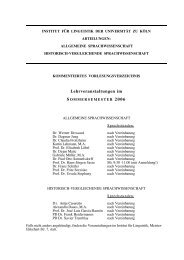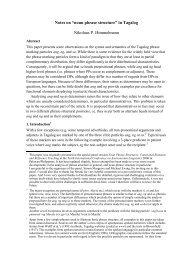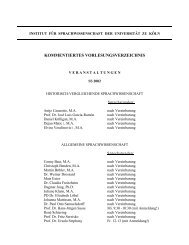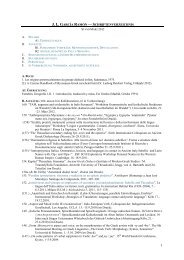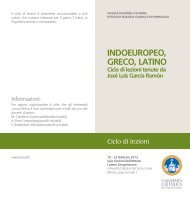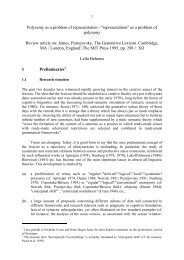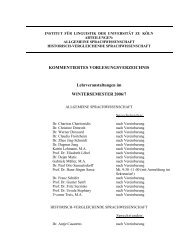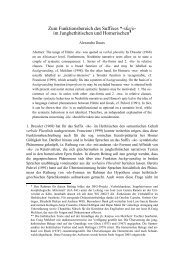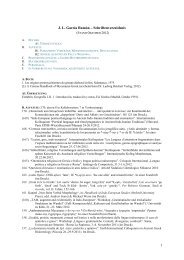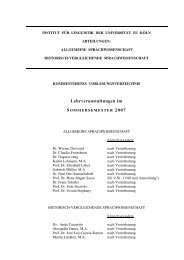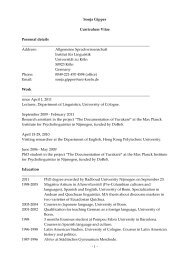Topics in Anatolian Historical Grammar Prof. Dr. H. Craig Melchert
Topics in Anatolian Historical Grammar Prof. Dr. H. Craig Melchert
Topics in Anatolian Historical Grammar Prof. Dr. H. Craig Melchert
You also want an ePaper? Increase the reach of your titles
YUMPU automatically turns print PDFs into web optimized ePapers that Google loves.
7<br />
5.2. Adverb+Noun (with deity or term of relationship as 2nd member; those with abstract<br />
2nd member probably <strong>in</strong>stead possessive compounds, listed below under IV.6.2):<br />
(27) /P(a)ri-Sarma-/, i.e. PRAE-ri+i-SARMA-ma- ‘forward (= most prom<strong>in</strong>ent) Šarruma’<br />
(HLuvian, KARKAMIŠ 4a, §2; Hawk<strong>in</strong>s 2000: 152); Epñ-xuxa- ‘beh<strong>in</strong>d-grandfather =<br />
great-grandfather’(?) (Lycian, TL 127,1; <strong>Melchert</strong> 2004: 93), Šr-quq- ‘super-/hypergrandfather<br />
(idem)’ (Carian; Adiego 2007: 419). See also complex Dd-epñ-newe- ‘Afterdescendant<br />
of Ida’ (Lycian, TL 98,1 et alibi; <strong>Melchert</strong> 2004: 93—analysis of last two<br />
elements with Carruba 1969: 275).<br />
5.3 Adjective+Noun (relatively rare and of varied types)<br />
(28) m Kummaya-LÚ- (*Kummaya-ziti-)‘sanctified man’ (HE; Laroche 1966: 97, and also<br />
on hiero. seal HE; Hawk<strong>in</strong>s apud Herbordt 2005: 259&299), m Piyama-(a)radu- ‘given<br />
devotee’ (HE; Laroche 1966: 141—for analysis see <strong>Melchert</strong> apud Yakubovich 2010: 93<br />
and compare with genitival first member m.d U-na-ra-du- = *Tarḫunna-aradu- and<br />
m Tarḫunda-(a)radu- ‘devotee of Tarhunt-’; Laroche 1966: 176-7), /Tiyamma-aradu-/, i.e.<br />
Ti-ia-ma+ra/i-tu- ‘__ed devotee’ (HLuvian, İVRİZ 1, §4; Hawk<strong>in</strong>s 2000: 516); also<br />
m SUM-ma- d LAMMA- ‘the given tutelary deity’ (HE; Laroche 1966: 141—for this<br />
<strong>in</strong>terpretation see <strong>Melchert</strong> 2011), m Ura-ḫattuša- ‘Great Hattusha’ and also hybrid Luvo-<br />
Hittite m Ura-walkui- ‘great lion’ (HE; Laroche 1966: 197) beside pure Luvian *Urawalwi-i.e.<br />
MAGNUS-LEO- (Hawk<strong>in</strong>s apud Herbordt 2005: 277), m Ura- d U- ‘great Stormgod’<br />
(HE; Laroche 1966: 198) and m GAL. d IŠTAR-a- ‘great Šaušga’ (HE; Trémouille<br />
2006); Enẽhi-nere/i- masc. ‘(of) sister of the same mother’ (Lycian, TL 137,1, thus per<br />
Oett<strong>in</strong>ger 1994: 318 with nasal perseveration for *ẽnehi-, effectively equivalent to<br />
Noun+Noun * Ene-nere/i- and type cited <strong>in</strong> 5.1.2 [21] end).<br />
5.4 Noun+Adjective:<br />
5.4.1 Ord<strong>in</strong>ary adjective:<br />
(29) m Maššana-ura- ‘great (one) of the gods’ (Hittite Empire; Laroche 1966: 115—cf.<br />
titles like tuppa(la)n-uri- ‘chief of the t.’); D-b(i)krm- ‘Ida-mighty’ (Carian; Adiego<br />
2007: 361—see Pik(a)rm- above under IV.2 [4c]); X-uśoλ- ‘X-blessed’ or similar,<br />
<strong>in</strong>clud<strong>in</strong>g Iduśol-/Duśoλ- = Ιδυσσωλλος ‘Ida-blessed’, Pnuśoλ and variants =<br />
Пονυσσωλλος ‘All-blessed’, Μαυσσωλλος likely ‘Much-blessed’(Carian; Adiego 2007:<br />
passim, but analysis of last with ma- = HLuvian ma ‘much’ < *mégh 2 , nom.-acc. sg.<br />
neut. is m<strong>in</strong>e—HCM; for uśoλ- see 6.1.4 below).<br />
5.4.2 Past participle (probably with sense ‘__ed by X’, but cf. 8.5.3 below):<br />
(30) Mahane-pijeme/i- ‘given by the gods’, Natrbbijẽme/i- ‘given by Natr’, “translated”<br />
by Ἀπολλόδοτος (Lycian, respectively N302,2 and N320,4; <strong>Melchert</strong> 2004: 98&100),<br />
latter = Νετερβιμος <strong>in</strong> Caria. NB also *Wese-pijeme/i- ‘given by/with W.’ = Οσαβαιμις <strong>in</strong><br />
Lycia—for last example see refs. <strong>in</strong> <strong>Melchert</strong> 2004: 107 and discussion <strong>in</strong> 8.5.3 below—<br />
and examples <strong>in</strong> first-millennium Lycia and Pisidia <strong>in</strong> -π(ε)ιμις (see Houw<strong>in</strong>k ten Cate<br />
1965: 177); Masa-uwẽt(i)- ‘favored/regarded by the gods’ (Lycian context N314a,4 with<br />
Milyan shape; cf. Schürr 2009: 102 and Unuwẽme/i- below <strong>in</strong> 5.5 [31]).



